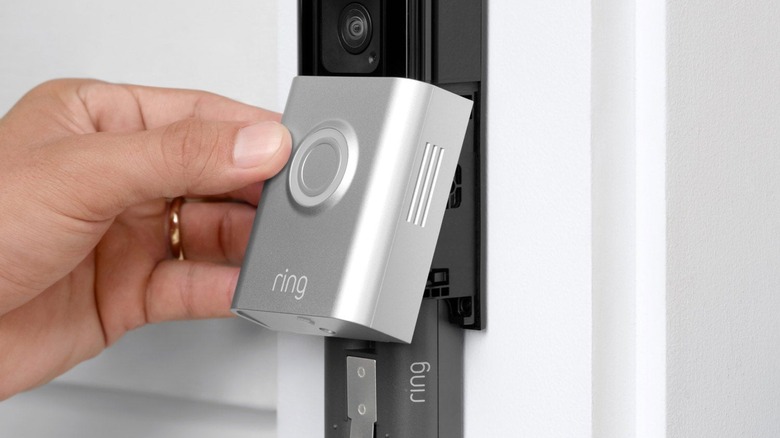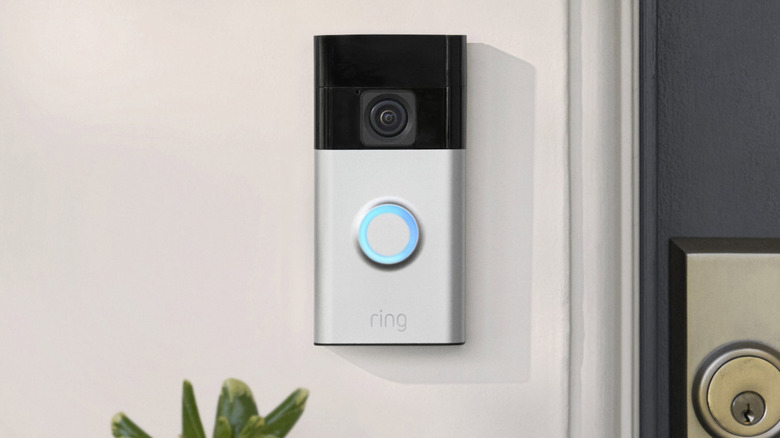Why Your Ring Doorbell Is Flashing Or Spinning White
Flashing, spinning, and oddly blinking LED indicators have become the modern equivalent of red warning lights on a car dashboard. Rather than giving every potential problem and function on a hypothetical device its own dedicated signal, an LED indicator can change its display size and pattern to indicate a variety of different status and potential hiccups. The only downside to this compared to individually labeled warning lights is that, if you don't know what each pattern means, it's not exactly helpful.
For example, if you own a Ring doorbell, you've probably noticed an LED indicator around its doorbell button. This indicator can light up in a couple of different colors and quite a few different patterns, most of which involve either spinning around or flashing in particular spots. Since the indicator's standby mode is indicated by a solid white light, most kinds of flashing and spinning are indicative of some kind of problem with the doorbell's functioning or authentication. If you don't speak digital sign language, here's what you need to know about these various patterns.
Spinning white indicates setup mode
If you've just taken your Ring doorbell out of the box and are setting it up, then you'll swiftly become familiar with one of its first major patterns: a white, spinning light. This is actually one of the few patterns on a Ring LED indicator that isn't indicating some kind of problem or update. When the indicator is spinning solid white, that means that the device is currently in setup mode, allowing you to perform all of the various tasks that go into the device's initial installation and connection to your home Wi-Fi and smart signals. Just be aware that the setup mode indicator times out after 10 minutes, so if the white spinning light goes away, you might need to start the process over again. If you need to reset your Ring doorbell, you'll likely see the white, spinning light again.
On a related note, if you see a blue light on your LED indicator that's not quite spinning, but rather incrementally cycling around, that's not a cause for alarm. That indicator appears on the first and second generation of Ring video doorbells if they're not connected to your home power grid. This light merely informs you of how much power is left on the internal battery. If the light has almost completely gone out, that means it's time for a recharge.
The precise meaning of flashing depends on the location and color of the light
Just about every other indicator that can appear on your Ring doorbell involves flashing white or blue lights, and the majority of these flashing indicators represent some kind of problem. The tricky thing is that the only way to know exactly what kind of problem you're experiencing is by checking the precise location of the light.
First, let's cover the lights that don't indicate a problem. While you're setting your Ring doorbell up, you'll probably see a blue light flashing from bottom to top. This means that the doorbell is currently attempting to connect to your home network. Additionally, at the end of the setup process, you should see four separate blue lights at the top, bottom, left, and right of the indicator flashing simultaneously. This means that the setup process was successful, and your Ring doorbell is ready to use. Finally, if the entire indicator is flashing white, this just means that the device is undergoing an internal firmware update, and there's no cause for alarm.
Now for the bad signals. There are three warning lights that can flash at the top, left, and right of the indicator, each signaling something different. If you see a white light flashing at the top, that means you've entered the wrong password into the Ring app, and the doorbell can't connect. If you see a white light flashing on the right, that means the doorbell is having problems connecting to the Ring Temporary Access Point, a temporary wireless connection used during the setup process. Finally, if you see a white light flashing on the left side, this means the doorbell has encountered a nonspecific kind of error. You'll probably need to contact support for that one.


